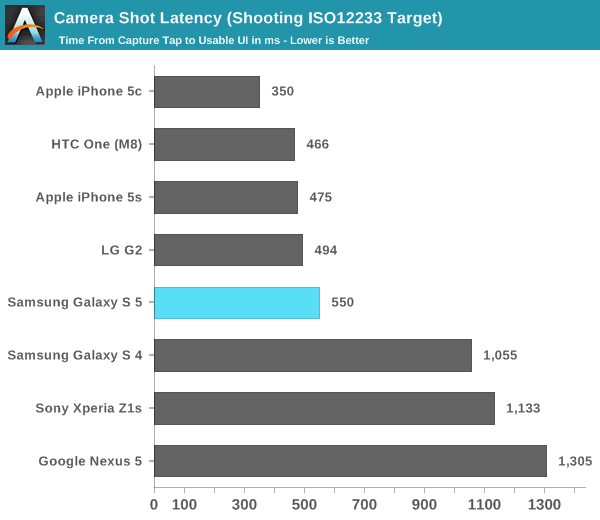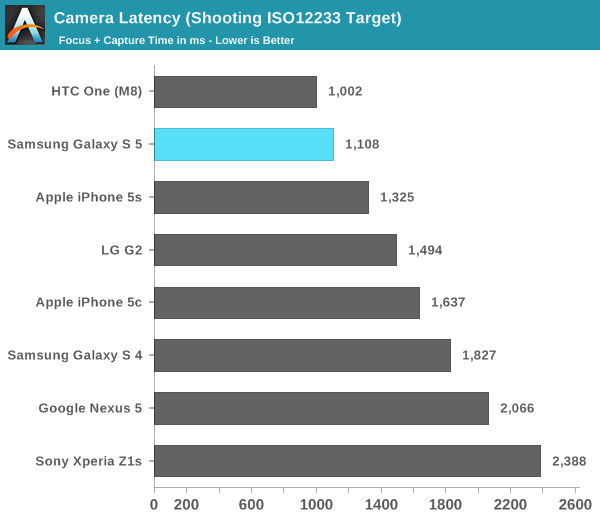Samsung Galaxy S 5 Review
by Anand Lal Shimpi & Joshua Ho on April 8, 2014 12:00 AM EST- Posted in
- Smartphones
- Samsung
- Mobile
- Galaxy S 5
Capture Latency
Along with its own rear facing camera sensor, the GS5 adapts a dual-mode autofocus system. Traditional AF designs in smartphones rely on testing contrast differences in order to determine when a point is in focus. With GS5, Samsung introduces a second mode: phase detection auto focus. Instead of relying (primarily) on contrast to determine focus, PDAF splits incoming light and compares intensity patterns to determine focus direction.
Low light scenes and scenes that can't generate appropriate phase info will default to contrast AF. PDAF appears to work across the camera's FOV although I did notice that the fastest AF times almost always happened in the center of the display.
Samsung claims a 300ms AF time thanks to its phase detection AF. In order to validate that claim I pointed a camera at a bunch of phones and measured AE/AF latency while preparing our ISO 12233 target shots from the previous page.
I measured from the moment I tapped the focus target to the time the image stopped moving (I didn't rely on the AF lock indicator as some devices report focus lock prematurely). There's a bit more variance than I'd normally like in these numbers due to the nature of the capture, although I'm working on getting a higher speed camera to smooth some of that out.

The GS5 definitely runs its AE/AF routine quickly, basically tying the M8 at the top of the charts here. The improvement over the GS4 is substantial, and there's even a big advantage over Apple's iPhone 5s. Note that if you move to lower light conditions you can see this number at least double, but that's something that impacts all of the devices here.
The Z1s is pretty frustrating because it has a great imaging system but an absolutely terrible camera UI. Focus speed is pretty bad compared to anything else here, basically on par with the iPhone 5/5c.
The shortest time to focus I was able to record on the GS5 was 450ms in a different test scene, compared to 516ms for the M8. The GS5 can definitely be a hair faster but I found the M8 to be comparable if not slightly quicker overall.
Focusing is just one piece of the puzzle, I also measured capture latency as well. Here I'm looking at the time between when I tapped the capture button on the screen and when the camera UI was ready to take another shot.

The GS5 remains solid, but here Apple actually pulls ahead. The 5c (and 5 by extension) are actually at the top of the charts here. Apple does some more work upon capture on the 5s, which is the only reason I can think of for the discrepancy here. Either that or the NAND on my 5s is in a dirtier state, impacting capture performance.
Either way there's a huge improvement in capture speed compared to the GS4. Capture latency is one area where the Nexus 5 is absolutely horrible in. The latest updates made AE/AF reasonably responsive, but the capture latency kills the experience on the N5.
This next chart combines the previous two values to give an overall picture of capture latency on these devices:

Samsung's PDAF and ISP companion seem to do their job well as the GS5 is substantially quicker than the GS4 at image capture. That being said, HTC's M8 is slightly faster by comparison.










296 Comments
View All Comments
xsoft7 - Tuesday, April 8, 2014 - link
just remove the touchwiz UI!every single samsung device has lags because of it!
after installing google edition\diffrent roms that not based on it, the lags dissappeard!
the UI is their most weak point, no matter how fast the cpu\gpu or ram will be, the ui, after several software insallation will L-A-G. just go over youtube and see it for yourself! wether it is GALAXY note 1,2,3 or galaxy s 12345, or tabs. they are lagging! (except google edition)
BedfordTim - Tuesday, April 8, 2014 - link
That is a deliberate feature put there so that you will upgrade to a "faster" phone.theduckofdeath - Tuesday, April 8, 2014 - link
The GS4 is the most stable phone of 2013. People who has actually held a phone know that people like you and xsoft7 are just trolling.http://www.androidcentral.com/apps-crashed-most-gi...
Give it up. No one cares about your opinion.
theduckofdeath - Tuesday, April 8, 2014 - link
*People who has actually held a GS4 know....Astarael - Tuesday, April 8, 2014 - link
*havenoel_newell - Friday, October 3, 2014 - link
In my opinion Galaxy S5 does not reach up to the same level as the competition, even from other Samsung phones (see http://www.consumertop.com/best-phone-guide/ ). For example HTC One M8 and Motorola Moto G are fantastic. But we can agree on one thing – Galaxy S5 wipes iPhone off the table any time of the day.earthrace57 - Tuesday, April 8, 2014 - link
I hate to break it to you, but how stable it is when using apps isn't exactly relevant when using touchwiz. On my friend's S4, there is noticeable slowing when doing motions in the basic UI, which is what we are talking about.theduckofdeath - Tuesday, April 8, 2014 - link
I hate to break it to you, every phone, no matter brand or OS can be slow if you install the wrong apps.Your "friends" phone is completely irrelevant to everybody who's actually used a GS4. Because we know you just full of it. How do I know I am more right than you? Because I know which Android phone is dominating sales. By a gigantic margin. If anything of what you're making up is true, Samsung wouldn't be as dominant, no matter how much money they would throw at their marketing department.
niva - Tuesday, April 8, 2014 - link
Dominating sales has nothing to do with what you're describing. Have you tried the google play version of the galaxy s? The one that comes with stock android and doesn't feature the silly overlays? Yup, runs more stable than the "regular" galaxy s and actually gets updated in terms of software.The reason why manufacturers drop those skins is not so they "look different" only but because they can somehow rationalize not updating the software on the device later and force you into an upgraded device sooner.
Anyone buying a non-nexus phone is in this boat unless they want to do some work on their own to keep the devices up to date and that doesn't always quite work out right in terms of stability.
darwinosx - Tuesday, April 8, 2014 - link
Even Nexus phones are not always updated immediately as we have seen in the last year.